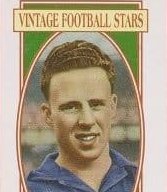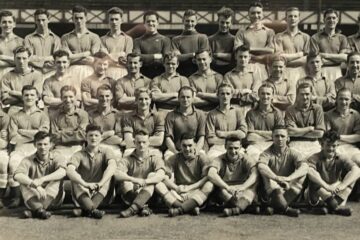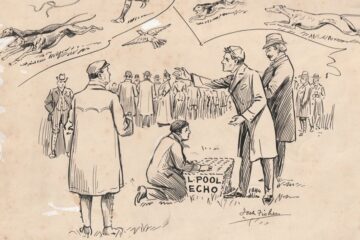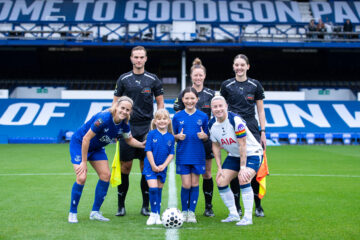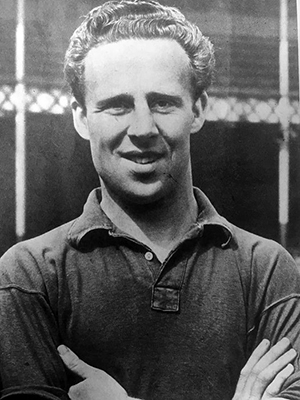
The telegram was succinct: ‘Best of Luck — may everything go well for you’. It had been sent by Tommy G Jones — the exalted Prince of Centre-Halves — to his namesake, 20-year-old Tommy E Jones, who was debuting for the Everton first team against Arsenal on 6 September 1950.
Tommy (often referred to as T E Jones in football circles — short for Thomas Edwin) would have the burden of succeeding the supremely gifted and ‘T G’. Nonetheless, he’d go on to carve out his own place in the Gwladys Street Hall of Fame. Looking back when interviewed for Three Sides of the Merseyin 1990, Tommy recalled playing alongside the Welshman (who left for Pwllheli in 1950):
“I played in the reserve-side one time, and he (T G) was playing on this particular occasion. He was possibly coming back after an injury or something and I played at right-back. I’d never played with T G before, although I’d seen him play and watched in awe. I was about 16 or 17 years of age. I remember this long ball came down the middle and he nodded it out to me on the wing – I picked the ball up and knocked it way down for the winger to chase after it. T G played merry hell with me. He wanted it back. He was standing on the edge of his own box. I thought, “Well, that’s the danger area.” He said, “I only gave it to you so you could give it back to me.” He had that sort of a presence, that sort of ability. He was a great player.”
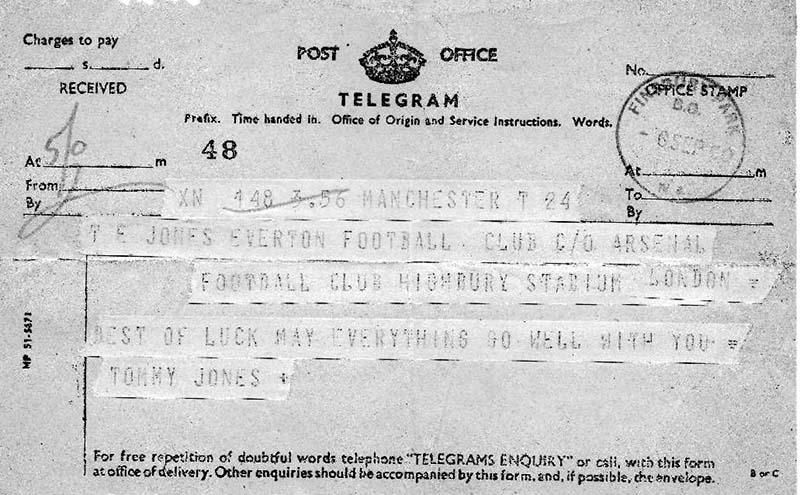
Telegram from T G Jones to T E Jones on his debut
Fazakerley-raised Tommy had been on Everton’s books since leaving St Margaret’s School (Anfield) at the end of the Second World War, turning professional three years later. He had captained the Liverpool County FA Youth side and had represented the British Army at right-back during his national service (playing in the same team as Bob Stokoe, who’d become a friend). His rise from the Everton third team to the first had been dramatic. When switched from full-back to centre-half for a couple of ‘A’ and reserve-team matches, he had impressed the Blues supremo, Cliff Britton. The Bristolian decided to throw Tommy – who at just shy of 5′-11″ was on the smaller side for a Number 5 – in at the deep end at Highbury, in place of Ted Falder. The Everton line-up that day was: O’Neill, Moore, Saunders; Grant, Jones (T E), Farrell; Buckle, Wainwright, Catterick, Fielding, Eglington.
Tommy suffered a significant injury (dislocated knee-cap) in the match, briefly coming off to receive treatment before re-entering the fray to applause from around the ground. Although Everton lost, 2-1, the newspaper reports were full of praise for the debutant. One headline declared: ‘Everton lose game — find centre-half’. The Evening Express reported: ‘It would be almost impossible for a player to make a more encouraging debut than Jones did in a game which saw all the breaks going in Arsenal’s favour.’
He was rushed back into the team seven days later for the return fixture against the Gunners – giving him his Goodison Park debut. It was too soon for the troublesome knee and he was not at his best. Recalled when fit for the visit of Manchester United in late October – a 4-1 defeat – Tommy played excellently. He went on an unbroken run of 29 appearances until the season’s end. It was Tommy’s misfortune to break-through in the season in which Everton were relegated to the Second Division for only the second time in the club’s history. Cliff Britton kept faith and Tommy was a near ever-present in the 3 seasons in the second tier and remained the holder of the Number 5 shirt – seeing off the challenge of Matt Woods – through the mid-1950s. The day that promotion was secured, with a 4-0 win at Boundary Park, was still fresh in Tommy’s memory when he was interviewed nearly 40 years later: “That was a great moment for everybody connected with the club. As we drove to Oldham the roads were packed with supporters cheering us on, waving banners and knocking on the windows of the coach.”
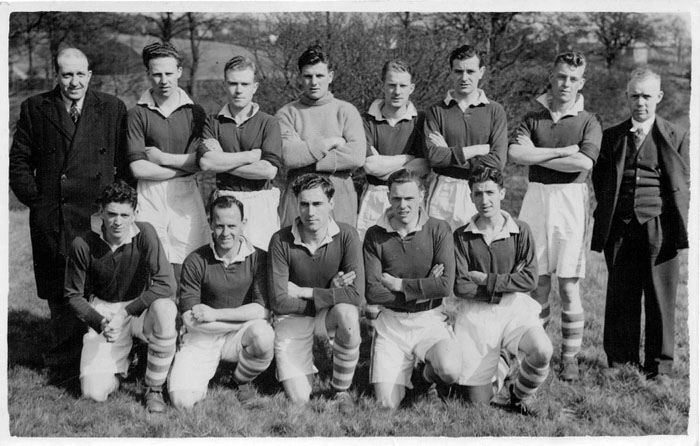
Everton youth team in the Peak District circa 1946; Tommy back row, 2nd from left
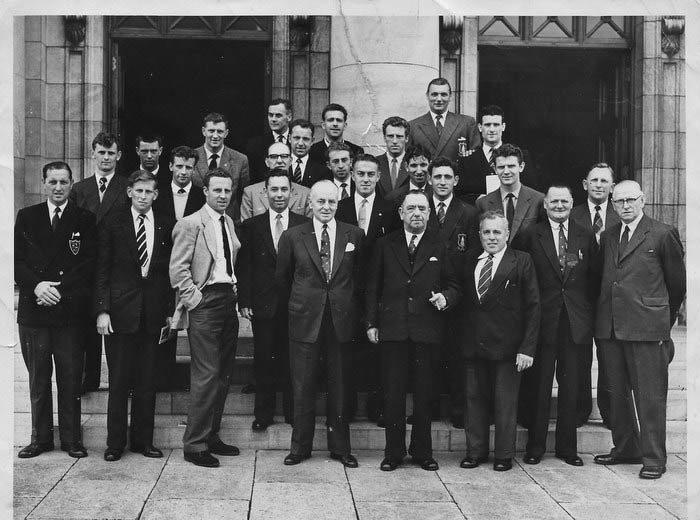
On tour with Everton in Cork
Tommy married Dorothy Freeman (‘Dot’ for short) in 1951 – they had four children together: Barry, Brenda, Brian and Colin. They spent the first 12 months of married life in a rented flat in Bootle until Jimmy MacIntosh left Everton, freeing up a club house on Wallace Drive in Huyton. Here, Tommy could relax by gardening and reading (when interviewed in 1955, he had just read the recently published HMS Ulysses and Len Shackleton’s ‘Crown Prince of Soccer’ memoir). His next-door neighbour was Toffees teammate Eric Moore – and subsequently Mick Meagan. By Meagan’s account, Tommy was the ideal neighbour: “He was one of the first players to have a motor car so he used to drive me into training. When I went home to Ireland during the summer holidays, he’d cut the grass in my garden for me! Our children played with his and became great friends.” Tommy enjoyed a round of golf with Mick and his friend Jimmy Tansey at the nearby golf course and was a regular attendee at boxing bouts in Liverpool.
The Everton team at this time was packed with experienced (and in some cases long-in-the-tooth) players like Peter Farrell, Harry Potts and Wally Fielding – with Tommy one of the youngest. He recalled what it was like to be selected and sit alongside these established footballers:
“To realise on a Thursday that your name’s on the team-sheet, that’s what it’s all about. Then you can start getting excited about the Saturday match. It’s strange in before-the-match situations in the dressing-room. All players have different things they like to do. I remember one time we were playing at Fulham. We, at that time all wore club suits, so we all turned out looking like Burton’s shop window. I remember that they used to number the shirts around: you’d start off goalkeeper, right-back…and I always used to change next door to Peter Farrell. I went to my pocket one day, after the match, and said, “What’s this?” It was a bottle of holy water. He’d been along to the local church that morning. Peter had obviously put it in the wrong pocket. And Cyril Lello – who was a good wag – said, “Here, I’ll have some of that. Sprinkle some on my knees.”
“These were the personalities. Talking about dress sense, there was a chap later on named Mickey Lill, and the lads used to take the mickey out of him because every day he came in looking identical: dark suit, white shirt. He was a dapper type. It was in those days when they wore separate collars. One day, they played a trick on him. Somebody bought a couple of shirt collars about two sizes smaller (and swapped them) – and could he hell get them on his neck after the training session? He was going puce in the face. That was the sort of thing they got up to, it was tremendous.”
The departure of Peter Farrell for Tranmere in October 1957 saw Don Donovan awarded the club captaincy but, when he moved-on during the following summer, the honour was given to Tommy — a proud moment for a local lad.
Like T G Jones before him, and Brian Labone after him, Tommy earned a reputation for being a firm but fair defender who resisted the urge to resort to the ‘dark arts’ to get the better of his opponent. He was too sporting for some supporters’ tastes who craved a centre-half with a touch more edge and ruthlessness – the sort exhibited by Roger Kenyon and Kevin Ratcliffe in later years. Mick Meagan recalls: “Tommy was a gentleman with a lovely sense of humour and a very good teammate to play with. He always went out to play the game as it should be played – he never went into a tackle to ‘do’ somebody.”
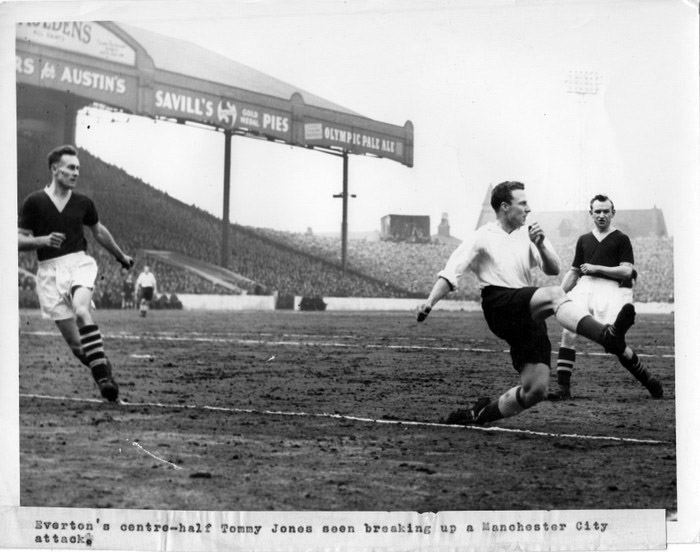
Tommy breaks up a Manchester City attack
Tommy led the team out when Everton unveiled their floodlights in October 1957 in a specially staged ‘Floodlit Cup’ match against the team from across the park. He told Rogan Taylor:
“I remember the first floodlit game we had at Everton, and we played Liverpool. Liverpool were in the Second Division at the time… We’d never played under lights before and it was absolutely fantastic. You ran on to the pitch and it was like treading on air, literally, with the volume. You couldn’t see the faces, you couldn’t see the people – but they were there, they made themselves known and it was absolutely fantastic. This was prior to the match because, obviously, once the game gets underway, your concentration is such that you forget completely other factors that might alter things. Yeah, it was a tremendous, fantastic feeling. And the supporters in those days were tremendous. You’re talking about average gates of 45 to 50 thousand.”
Tommy never won full international honours for England but was selected to play for an England XI against an Army XI at Maine Road and also toured Nigeria and Ghana in 1958 in an FA squad of seasoned professionals.
At the back end of the 1950s, with the team now managed by Johnny Carey, Tommy found his place in the first team under increasing threat, as he told the matchday programme in 1981: “I was starting to get on a bit and young Brian Labone was knocking hard at the door. In fact, he knocked so hard that they had to open it and let him in.”
With Labone in the centre, Tommy moved over to left-back in the 1959-60 season but the emergence of Colin Green and the acquisition of George Thomson in December 1960 heightened the competition for the Number 3 shirt. From that point on, Tommy was very much a squad player. His final match in the first team came in an evening fixture on 6 September against visitors Manchester City. City took the lead when Peter Dobing’s shot cannoned off Tommy, sending Albert Dunlop the wrong way. The Citizens ran out 2-0 winners. Michael Charters of the Echo was sympathetic:
Tom Jones, a late substitute for the injured Labone, did very well against the speedy Baker, and no-one can blame him for the own goal. Considering that this was Jones’s first appearance at centre-half in the League side for two seasons, his performance is all the more praiseworthy.
By now, Tommy’s former club-mate, Harry Catterick, was Everton manager. Tommy reflected on the new management team’s style:
“He (Catterick) brought with him Tommy Eggleston. Tommy was really his right-hand man, no doubt about it. He was the guy who made it gel, he was the guy who made it happen, he was the guy who could talk tactics to the players. The Catt, as they called him, was the iron man. He was certainly a man-manager, but you never knew where you stood with Harry Catterick. He was the type of person who could talk to you as if the best of friends and the next day he’d walk past you as if you didn’t exist. Probably the things he had on his mind… His attitude was such that, if you weren’t in, you certainly knew that you weren’t in. You knew you’d been segregated to train with others, and you knew immediately that you weren’t in his good books.”
Catterick’s first summer at Everton (1961) was largely taken up by a tournament staged in the USA. During the time in the States, Tommy unexpectedly found himself asked to be ready to fill a new position in the team:
“It’s funny; we only had one goalkeeper with us. I wasn’t considered as a first-team player – I was along to make up the numbers, basically, should anybody be unfortunate to get injured. But I was the stand-by goalkeeper. I’d never played in goal in my life. It was rather funny actually, because we were playing six-a-side in one of the training sessions, and the Catt said to me, “You’d better go in goal, get a feel of the ball.” And I remember Roy Vernon hit a shot and I went to grab the ball and it hit right on the end of my finger – nearly broke it in two. I was in agony, I really was. Fortunately, I was never needed!”
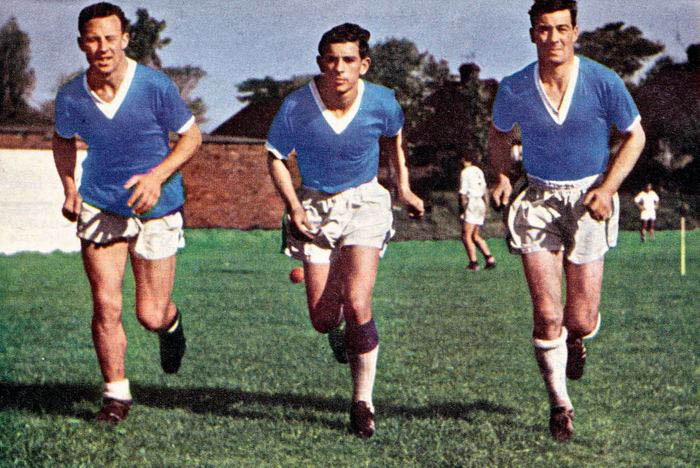
Tommy in training, 1961
On 18 November 1961, the curtain came down on Tommy’s top-level playing career when his knee-cap was fractured in what was described as a ‘collision with Cartwright’ in a report (Derek Temple, who witnessed the incident, described it to me in less euphemistic terms). He was carried off the field and underwent surgery in a Barnsley hospital. Among his first visitors to his bedside was the Football League president, Mr Joe Richards, who took him a basket of fruit and wished him well. Tommy Ring – who had just been transferred from Everton to the Tykes – was another visitor.
Tommy returned to Merseyside a couple of weeks later with his leg in plaster – it was announced at Christmas that he’d play no further part in the 1961-62 season. He worked hard through the summer of 1962 to get back to match fitness but was never again considered for first-team duties. Instead, he appeared for the third (A) team during the 1962-63 season — helping to develop the younger players. It is a great shame that such a loyal servant to the club should have just missed out on being involved in the golden era that was dawning.
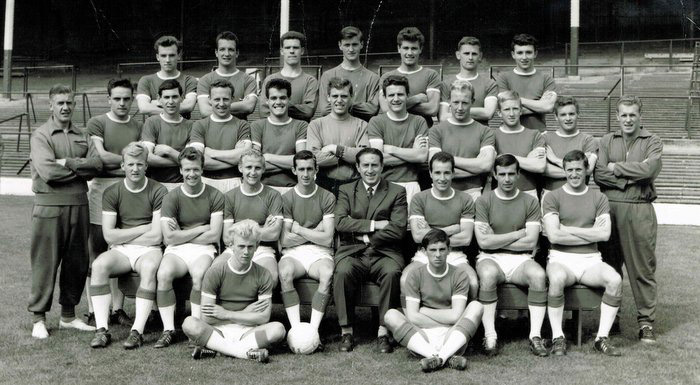
T E Jones’s last season at Everton, 1962-63, with Tommy 3rd row 4th from left
On 1 May 1963, it was made public that Tommy was, with Everton’s consent, being released to take up a coaching position with the Montreal Italia Club. Prior to his departure for Canada in mid-May, he received his third and final benefit cheque to the value of £1,000 in recognition of his long service to the club. Michael Charters, in reporting on Tommy’s new venture abroad, praised his contribution to the Toffees as ‘a scrupulously fair and genuine player’. Tommy left the club he loved after making 411 senior appearances. (As of April 2020, he is the 14th highest appearance-maker for the Toffees.)
Football in Canada at this time was largely the preserve of European and South American players and one newspaper report suggested that clashes of temperament on the field of play were frequent. Tommy, however, was able to calmly guide his mainly Italian charges to the League and Cup double. He returned to England in September 1963 – although Montreal were keen for him to return the following spring, he elected to remain in the UK with his family. He was immediately employed by Chorley FC of the Lancashire Combination as player—coach but resigned in the autumn citing the pressure of work. That work was for The Littlewoods Organisation. John Moores had seen to it that Tommy was offered employment overseeing the fit-out of stores across the land. He’d perform this role until his retirement but he was not quite done with football. In December 1963 he (and former Liverpool forward, Louis Bimpson) joined Burscough FC as players and enjoyed a final few months as a footballer. That season, he also attended an Ormskirk Everton Supporters Club event – also attended by the Everton First Team squad – where he and Albert Dunlop were presented with clocks in recognition of their contributions to the Blues.
In spite of Tommy’s role with Littlewoods demanding a lot of his time (and requiring many miles to be driven), he still found time to coach Everton youngsters. He’d take training at Bellefield for schoolboys two evenings per week (later switching to administration duties) and also ran the club’s C team at weekends. Future first-teamers Dave Jones and Neil Robinson came under Tommy’s tutelage in the C team. Dave Jones recalls: “I have nothing but good memories of Tommy from my time as a young player. He was themain man who we would go to after training on a Tuesday and Thursday night to get our expenses for the bus fare home. And he was at the C team games on a Sunday to give his wisdom. The one thing I remember was him telling me that I would play for Everton and to listen and learn – and when I had 25 first games under my belt, I might have something to say. He told us it was an honour to wear the royal blue shirt and to respect the club and the players who went before us. Being a defender himself, I think he always had a soft spot for the defenders coming through, and always had the time to talk to us on how we trained, played and what we needed to improve.”
Neil Robinson is similarly effusive about Tommy: “I had left school at 15. When I first started at Everton in 1972-73 they just threw you in the Everton C team in a Sunday league – that was your trial. We were playing against grown men so it was a bit of a footballing education! Tommy ran that team so that is how I first met him. He was fantastic, a lovely person – and always had a smile on his face. He never shouted at us – it was always encouragement. It is thanks to him that my Everton career got off the ground. My elder brother Ian, who drove me to matches, had a word with Tommy to ask if, because I wasn’t working, there was a chance that I could go down to Bellefield for training. He could have just said No but he spoke to Ray Minshull and, after that, I was training (still as an amateur) at Bellefield everyday in full view of everyone. So it was down to Tommy – he must have seen something in me to recommend me.”
Tommy was offered the full-time Youth Development Role at the club in 1972 but preferred to remain with Littlewoods (Ray Minshull was appointed). After coaching, Tommy switched to a scouting role (whilst still doing midweek admin) – watching future opposing teams for Harry Catterick, Billy Bingham, Gordon Lee and, finally, Howard Kendall. The weekly reports were typed up by his daughter, Brenda, before being submitted to the club on a Monday morning.
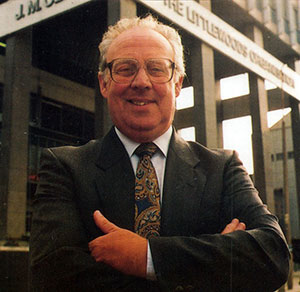
T E Jones 1991 outside Littlewoods Head Office
In retirement, Tommy would lose his wife Dorothy to illness but, some years later, married Pat in a ceremony held at the Alex Young Lounge at Goodison Park. Tommy still lived in Huyton and remained a regular and popular presence at Goodison Park with his grandson on match days until close to his passing on 5 June 2010. Just a few months earlier, the whole family attended a home fixture against West Ham United to mark Tommy’s 80th birthday and he was invited onto the pitch to receive the congratulations of the crowd (those in the ground not appreciating that it was also a farewell). In those final months of his life, whilst battling Leukemia, he and the family were grateful to Rev Harry Ross and the Everton Former Players Foundation for the support given. The funeral took place at St Luke’s next to Goodison Park at which family and friends were joined by former teammates of Tommy including Derek Temple, Jimmy Harris and Mick Meagan who travelled over from Dublin.
Brian Labone is described as the ‘Last of the Great Corinthians’ but we should not forget that he was preceded by another great one in Tommy. There is no higher praise than to quote coach and former player Gordon Watson: “Tommy was the most gallant man to have ever worn Everton’s colours.”
Acknowledgements/Thanks to:
The Jones family
Dave Jones
Mick Meagan
Neil Robinson
Billy Smith (bluecorrespondent.co.uk)
Source material:
Interview conducted with Tommy for Three Sides of the Mersey by Rogan Taylor (with thanks to Andrew Ward)
Liverpool Echo
Evening Express
Everton matchday programmes from 1981 and 1991
Everton: The Official Complete Record (Steve Johnson)
The Everton Encyclopedia (James Corbett)
Gwladys Street’s Blue Book (David France and David Prentice)
Photo sources:
Everton match day programme
Jimmy Harris
The Jones family
Rob Sawyer’s collection

